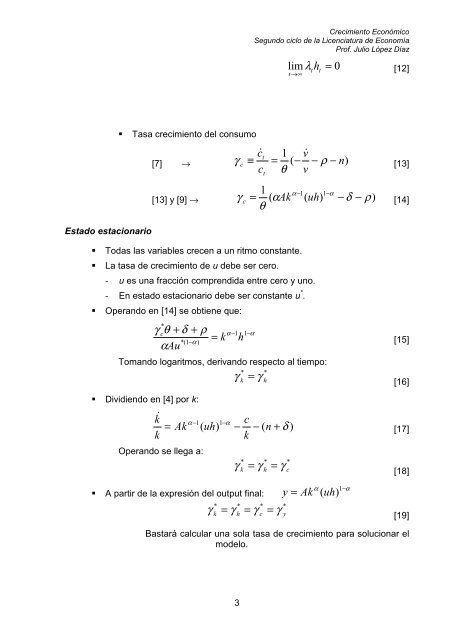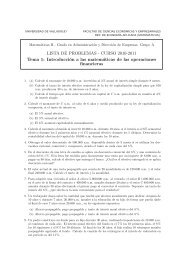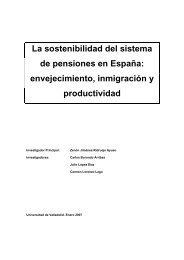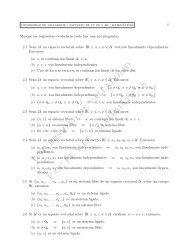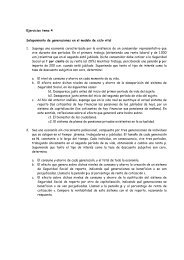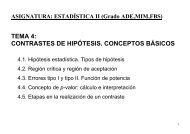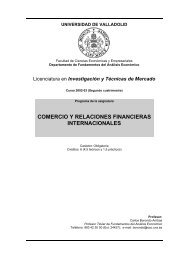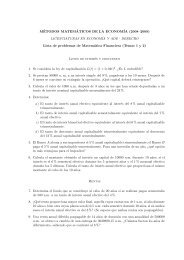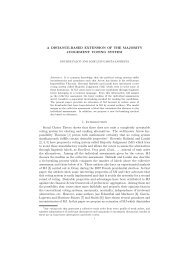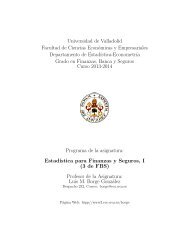Tema 8 Capital humano y crecimiento económico. El modelo de Lucas
Tema 8 Capital humano y crecimiento económico. El modelo de Lucas
Tema 8 Capital humano y crecimiento económico. El modelo de Lucas
You also want an ePaper? Increase the reach of your titles
YUMPU automatically turns print PDFs into web optimized ePapers that Google loves.
Crecimiento Económico<br />
Segundo ciclo <strong>de</strong> la Licenciatura <strong>de</strong> Economía<br />
Prof. Julio López Díaz<br />
lim h = 0<br />
t→∞<br />
λ [12]<br />
t<br />
t<br />
<br />
Tasa <strong>crecimiento</strong> <strong>de</strong>l consumo<br />
1<br />
θ<br />
t<br />
[7] → γ<br />
c<br />
≡ = ( − − ρ − n)<br />
c<br />
c<br />
t<br />
v<br />
v<br />
[13]<br />
1 1<br />
α−1<br />
−α<br />
[13] y [9] → γ<br />
c<br />
= ( αAk<br />
( uh)<br />
− δ − ρ)<br />
[14]<br />
θ<br />
Estado estacionario<br />
<br />
<br />
<br />
Todas las variables crecen a un ritmo constante.<br />
La tasa <strong>de</strong> <strong>crecimiento</strong> <strong>de</strong> u <strong>de</strong>be ser cero.<br />
- u es una fracción comprendida entre cero y uno.<br />
- En estado estacionario <strong>de</strong>be ser constante u * .<br />
Operando en [14] se obtiene que:<br />
*<br />
γ<br />
cθ<br />
δ<br />
αAu<br />
ρ<br />
+ + α −1<br />
1−α<br />
= k h<br />
*(1− α )<br />
Tomando logaritmos, <strong>de</strong>rivando respecto al tiempo:<br />
γ =<br />
* *<br />
k<br />
γ h<br />
[15]<br />
[16]<br />
Dividiendo en [4] por k:<br />
kC α −1<br />
1−α<br />
c<br />
= Ak ( uh)<br />
− − ( n + δ )<br />
k<br />
k<br />
[17]<br />
Operando se llega a:<br />
γ = γ = γ<br />
*<br />
k<br />
*<br />
h<br />
*<br />
c<br />
[18]<br />
<br />
A partir <strong>de</strong> la expresión <strong>de</strong>l output final:<br />
γ = γ = γ = γ<br />
*<br />
k<br />
*<br />
h<br />
*<br />
c<br />
y<br />
*<br />
y<br />
=<br />
Ak<br />
(uh)<br />
α 1−α<br />
[19]<br />
Bastará calcular una sola tasa <strong>de</strong> <strong>crecimiento</strong> para solucionar el<br />
<strong>mo<strong>de</strong>lo</strong>.<br />
3


